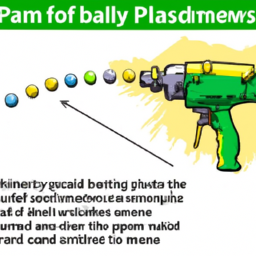Paintball Guns How They Work
Table of Contents []
How Paintball Guns Work
Introduction
Paintball is a fun and intense game that has become increasingly popular over the years. Whether you're taking part in a one-day event or a full-fledged tournament, knowing how a paintball gun works is an important part of the game. This article will delve into how paintball guns function in order to help you become a better paintball player. We'll cover topics such as the anatomy of a paintball gun, the firing mechanism, the pressure systems involved, and how to maintain and clean your paintball marker. We'll also discuss popular subtopics such as the types of paintball guns available, how to choose the right paintball gun for you, the different paint and ammo types, and much more.
Anatomy of a Paintball Gun
One of the most important topics to understand when it comes to using a paintball gun is its anatomy. A paintball gun consists of four major components: the barrel, the hopper, the stock or receiver, and the trigger assembly. The barrel is the metal tube that the paintball travels down and it determines the accuracy of your shots. The hopper holds the ammo and feeds it into the paintball gun, while the stock or receiver houses the inner components and provides a surface to hold onto. Finally, the trigger assembly is used to fire the paintball gun.
Firing Mechanism
In order to fire a paintball gun, you must first understand how the firing mechanism works. There are three main parts to the firing mechanism: the trigger, the sear, and the valve. When you pull the trigger, you're actually making the sear move up and releasing the valve. This allows air pressure to push through the valve and propel the paintball out of the barrel.
Pressure Systems
Most paintball guns use compressed air to propel pellets, but some use C02 gas canisters to generate pressure. There are pros and cons to both types of pressure systems. C02 canisters are cheaper and easier to find, but the C02 inside the canisters is very cold and can affect the accuracy of your shots, as the pressure is not consistent. Compressed air is more expensive but more accurate, as it offers consistent pressure and can be adjusted to your needs.
Maintaining and Cleaning
Proper maintenance and cleaning of your paintball gun is essential for optimal performance. A paintball gun is somewhat delicate and requires careful handling. It's important to clean your gun regularly, as dirt and gunk can build up in the barrel, causing paintballs to get stuck and impede their progress. You should also oil, lubricate, and check the seals of the paintball gun to make sure everything is functioning properly.
Types of Paintball Guns
There are many different types of paintball guns available for purchase today. The most common types are pump markers, mechanical markers, semi-automatic markers, electronic markers, and paintball sniper rifles. Pump markers are the most basic type of paintball gun and are favored by beginners, as they are the easiest to use. Mechanical markers are powered by manual hand pumps and are great for close-range play. Semi-automatic markers are powered by a CO2 or compressed air tank and can be fired continuously with each trigger pull. Electronic markers are powered by compressed air and feature various settings for more precise shots. Paintball sniper rifles are made to shoot accurately from a distance and require a great deal of skill to use.
Choosing the Right Paintball Gun
When it comes to choosing the right paintball gun, there are a few factors to consider. It's important to take your skill level into account when selecting a gun. If you're a beginner, a simple pump or mechanical marker is the best choice, as they are easy to use and require less maintenance. If you're an experienced player, a semi-automatic or electronic marker may be a better option, as they offer more control over your shots.
Paintball Ammo and Paint Types
The type of paint and ammo you use will also affect the performance of your paintball gun. Paintballs come in various sizes and colors, so it's important to choose the right type for your needs. The most common sizes are .68 cal, .50 cal, .43 cal, and .40 cal, although larger and smaller sizes are also available. The type of paint you choose can also affect your accuracy, so it's important to take your environment into account. If you're playing indoors, a water-soluble paint is best, as it won't stain walls or furniture. If you're playing outdoors, a non-toxic, long-lasting paint is best.
Conclusion
In conclusion, understanding how a paintball gun works is an essential part of becoming a better paintball player. We discussed important topics such as the anatomy of a paintball gun, the firing mechanism, the pressure systems involved, and how to maintain and clean your paintball marker. We also discussed popular subtopics such as the types of paintball guns available, how to choose the right paintball gun for you, the different paint and ammo types, and much more. Knowing this information can help you make the most of your paintball experience.

Previous Page
